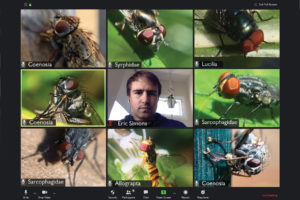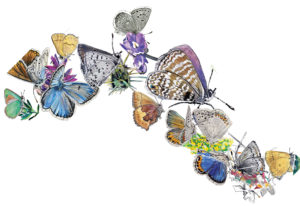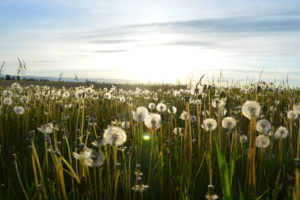When she gets out of the shower in the morning, Sue LaTourrette might find herself standing 10 feet from a great egret. “We live on a creek,” she says, “so we were used to wildlife. But we never had herons and egrets before!”
These days, great blue herons, hawks, and songbirds are frequent visitors. Raccoons stop by nightly. Last winter, Sue chronicled the courtship of mallards from her family’s prime wildlife viewing area: a pair of windows spanning the corner of the bathroom.
Peter and Sue LaTourrette’s home, though it is on a level cul-de-sac off a busy Los Altos boulevard, does not present the usual suburban face of prim foundation plantings surrounded by sod. About six years ago, the LaTourrettes killed the lawn and ripped out the swimming pool. Bermuda grass, star jasmine, oleander, and cement were replaced with a broad, shallow pond and waves of diverse native vegetation meant to entice visitors in carapace, feathers, or fur. The back of the lot is shaded by a massive valley oak whose roots extend deep into the banks of Permanente Creek.
Another huge tree anchors the entrance to the LaTourrettes’ modest home—a nonnative magnolia. It survived the garden conversion simply because it was too big to take out, but a few other exotics have been permitted to remain for other reasons. Sue and Peter cherish a Japanese maple that graces the walkway along the front of the house. And Peter, who is an avid birder, guiltily showed me a tobacco tree he put in behind the house. “It can be invasive,” he says, “but it’s a rich, rich hummingbird plant.”
The majority of the one-third-acre lot, however, has been given over to California natives. Low mounds and field stones set off a chaparral area, where brilliant magenta lavatera offsets more subdued hues of white sage. Bees congregate at coyote mint’s whorls of purple flowers. Yarrow grows everywhere, its blooms here maroon instead of the more common white. Adding ballast to all this color are the evergreen leaves of Catalina currant. “We have a lot of species from the Channel Islands,” Sue explains. “When we started out,” Peter adds, “we didn’t know about the distinction between California and local natives. But we’ve learned about it since.”
Peter LaTourrette was a birder, not a gardener, when he and Sue decided to renovate their yard. “I wanted an English cottage garden—with California natives,” Sue says. “I wanted paths. I wanted to bring birds and butterflies into the yard.” Sue drew up a plant list, then another one, and another. She found ongoing inspiration at nurseries, botanic gardens, and the Yerba Buena Nursery demonstration garden.
Modification has continued, based on messages from the garden itself. It took the LaTourrettes three tries to find the right spot for their shade-tolerant coral bells, for example. The berms they built for structural variety, it turns out, also provide well-drained soils. Around the pond, Sue and Peter planted six sedges. Now there are two dozen. “So many plants reseed themselves,” says Sue. “They go where they want to. It’s good to have a plan,” she adds, “but you’ve also got to be willing to let nature take its course.”
Peter takes lessons from the garden, but he also draws inspiration (and plant materials) from farther abroad. After losing a number of plants to the soggy spot behind the pond, Peter tried a scrub willow from Del Norte County. He planted yerba mansa under the willows when he noticed an association of these two plants along the Kern River in Southern California. Both have flourished and are now part of a diverse assemblage of California native plants that has no analogue in nature but provides an abundance of food for wildlife.
The garden’s success as habitat has been recognized by warblers, waxwings, dozens of bees—and environmentalists. On display inside is a certificate from the National Wildlife Federation, identifying the garden as Backyard Wildlife Habitat #29302, providing animals with food, water, places to hide, and places to raise young.
At an estimated 300 years of age, the immense oak near the creek serves as a beacon to the birds, signaling the presence of water and the creek’s high-quality habitat. Sue and Peter have capitalized on their proximity to the creek to draw into their yard many bird species attracted to water. The week that I visited, a Cooper’s hawk—a species that in the Bay Area inhabits riparian corridors—stopped in for a drink at the LaTourrettes’ pond
Peter and Sue are clearly in love with their bit of land beside Permanente Creek. Peter says he spends about seven hours a week in the garden, tending the pond and “puttering, planting, moving plants.” For anyone who wants to learn about native plants, Peter recommends choosing an area to experiment; it doesn’t have to be the whole garden. And start planting. But, he reminds us, “you’re on an annual cycle, so you don’t learn things immediately. In the garden, you’ve got to give it all a little bit of time.

.jpg)



